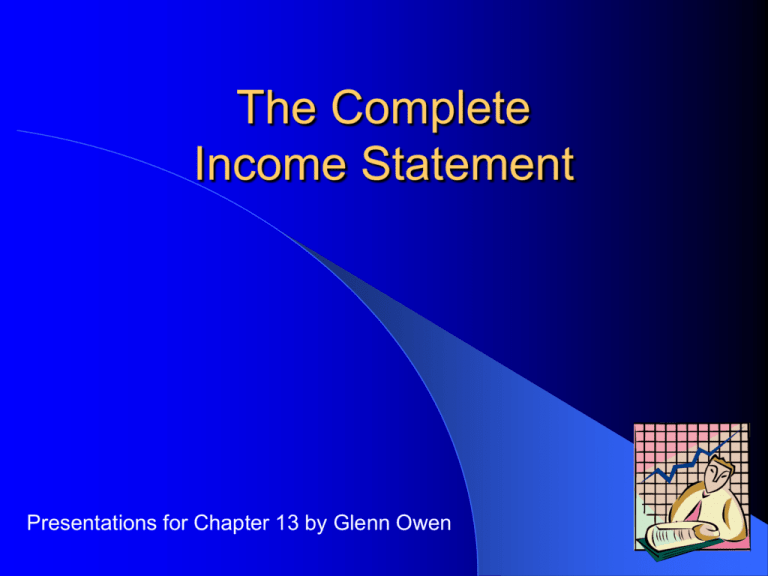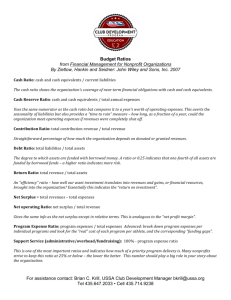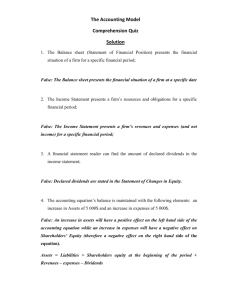
The Complete
Income Statement
Presentations for Chapter 13 by Glenn Owen
Key Points
Economic consequences associated with reporting
net income.
A framework for financing, investing, and operating
transactions.
Categories that constitute the complete income
statement and how they provide measures of income
that address the objectives of financial reporting.
Intraperiod tax allocation.
Earnings per share disclosure on the income
statement.
Economic Consequences
Income as a measure of company performance
Income’s affect on stock prices
Income’s affect on bond prices
Elements of the
Financial Statements
Assets
Liabilities
Equity
Investments by owners
Distributions to owners
Comprehensive income
Revenues
Expenses
Gains
Losses
Classifying Financing, Investing,
and Operating Transactions
Financing and Investing
Transactions
Operating
Transactions
Income
Statement
Balance Sheet
1
2
3
4
1. Exchanges with stockholders
2. Exchanges of liabilities and stockholders’ equity
3. Issues and payments of debt
4. Purchases, sales, and exchanges of assets
5. Revenues and expenses
5
Classifying Operating
Transactions
Transitory
Group C
Gains and losses due
to change in
accounting
principles
Extraordinary
items
Persistent
Group B
Group A
Revenues and Normal and recurring
expenses from
operating revenues
activities not
and expenses
germane to a
company’s primary
activity
Disposals of
segments
Other revenues
and expenses
Disclosure and Presentation
Operating revenues and expenses: usual and frequent
Other revenues and expenses: unusual or infrequent
Disposal of a business segment
Extraordinary items: unusual and infrequent
Changes in accounting principles
Earnings-Per-Share
Disclosure
Separate EPS disclosure for:
– Net income from continuing operations (after tax)
– Disposals of business segments
– Extraordinary items
– Changes in accounting principles
Calculation
– Separate dollar amount (from above categories)
divided by number of
common shares outstanding
Diluted earnings per share
Review Problem
Machinery with an original cost of $14,000 and a
book value of $11,000 was sold for $9,000.
(Unusual but not infrequent)
Cash (+A)
Accumulated Depreciation (+A)
Loss on Sale (Lo, -SE)
Machinery (-A)
Sold machinery.
9,000
3,000
2,000
14,000
Review Problem
A separate line of business (segment) was sold on March
14, 2003, for $18,000 cash. The book values of the assets
and liabilities of the segment as of the date of the sale were
$10,000 and $4,000, respectively. The business segment
reported revenues of $18,500 and expenses of $14,000.
Gain on
Revenues
Income
Cash
(+A)
Summary
Sale
of the
(-Ga,
Segment
(E,
-SE)
-SE)
18,500
18,000
1,530
4,080
Liabilities
Expenses
Income
(-L) Tax
ofLiability
the Segment
(+L)
4,000 14,000
1,530
4,080
Recognized
Income
Assets
income
(-A)
Summary
tax liability ($12,000
related tox2003
34%).operations
10,000
4,500
Recognized
($4,500
Gain
x 34%).
on
business
Sale (Ga,
segment
+SE) income.
12,000
Sold business segment.
Review Problem
On September 12, 2000, Panawin retired, before maturity,
outstanding bonds with a face value of $120,000, for a cash
payment of $130,000. The bonds were originally issued at a
premium, and the unamortized premium as of the date of
retirement was $3,000. (Extraordinary)
IncomePayable
Bonds
Tax Liability
(-L) (-L)
Unamortized
Loss onPremium
Retirement
(-L)(-Lo, +SE)
Loss on Retirement
Recognized
tax benefit
(Lo,($7,000
-SE) x 34%).
Cash (-A)
Retired outstanding bonds.
120,000
2,380
3,000
7,000
2,380
130,000
Review Problem
The company changed its inventory flow assumption
from the last-in, first-out (LIFO) to first-in, first out
(FIFO). This change increased the ending inventory
balance for 2003 by $8,000.
Income from
Inventory
(+A)
Accounting
8,000
Change
Income
(-Ga,from
-SE)
2,720
Income
Accounting
Tax Liability
Change
(+L)
(Ga, +SE)
Recognized additional
change from
taxLIFO
liability
to FIFO.
($8,000 x 34%).
8,000
2,720
COPYRIGHT
Copyright © 2003, John Wiley & Sons, Inc. All rights reserved.
Reproduction or translation of this work beyond that permitted in
Section 117 of the 1976 United States Copyright Act without the
express written permission of the copyright owner is unlawful.
Request for further information should be addressed to the
Permissions Department, John Wiley & Sons, Inc. The purchaser
may make back-up copies for his/her own use only and not for
distribution or resale. The Publisher assumes no responsibility
for errors, omissions, or damages, caused by the use of these
programs or from the use of the information contained herein.








